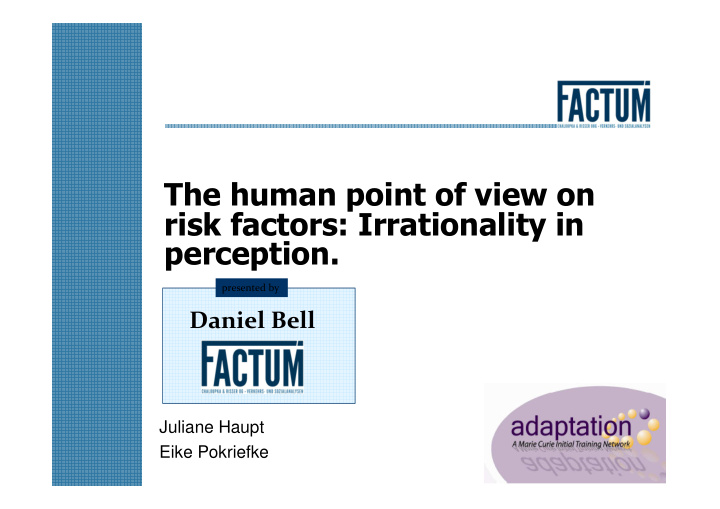



The human point of view on risk factors: Irrationality in perception. presented by Daniel Bell Juliane Haupt Eike Pokriefke
Methods I Participiants Methods I • N = 20 drivers (14 ♂ , 6 ♀ ; M = 39.15years; SD = 15.869 years ) Findings I • Driving experience > 10,000km • Driving distance per year > 5,000km Methods II • ADAS experience: range from hardly any up to very extensive experience Findings II Discussion & Conclusion
Methods I Procedure • Before: questionnaire asking for demographic information & level of Methods I DAS experience Findings I • (1.) Did you - and if yes, when did you first - use the particular system? • (2.) How often do you currently drive with the particular system Methods II activated? and • (3.) How familiar do you feel with the particular DAS? Findings II •4 Focus Groups (2 mixed-; 1 low-, 1 high DAS experience) Discussion & Conclusion
Findings I Perceived Risk Methods I “I feel safe on Austria’s roads.” “I’m afraid of youngsters that overestimate their skills.” Findings I “Many foreigners do not care about speed limits.” Methods II “Cyclists behave outside of laws. Even is they have a better view, it’s still risky.” Findings II „There are some risk groups: Opel-drivers; BMW-drivers, men with hats, women with glasses. Many public persons make jokes of Opel drivers. There must be truth in it. I‘m sure that‘s statistically verifiable. For Discussion & instance BMW drivers: when someone jostles you, this is in 50% of the Conclusion cases a BMW driver. And also the cliché of the ‚Sunday driver‘ is correct.“
Findings I Perceived behavioural control Methods I “ I think, I control my car in every situation.” “I believe that I can avoid an accident actively.” Findings I “Many foreigners do not care about speed limits.” Methods II “I’ve balanced the errors of others already quite often.” “You have to compensate a lot of problems that other road users Findings II cause.” “I think I can compensate the wrongdoing of others often. That Discussion & happens again and again ...” Conclusion
Methods II Participiants Methods I • N = 206 drivers (118 ♂ , 88 ♀ ; M = 41.22 years; SD = 14.230 years ) Findings I • Driving experience of majority (N = 193) > 10,000km • ADAS experience: range from hardly any up to very extensive Methods II experience Findings II Discussion & Conclusion
Findings II Perceived risk I Methods I M = 3.14, SD = 1.226 Findings I Methods II Findings II Discussion & Conclusion
Findings II Perceived risk II Methods I M = 4.82, SD = 1.443 Findings I Methods II Findings II Discussion & Conclusion
Findings II Perceived behavioural control I Methods I M = 4.84 SD = 1.180 Findings I Methods II Findings II Discussion & Conclusion
Findings II Perceived behavioural control II Methods I M = 4.10, SD = 1.472 Findings I Methods II Findings II Discussion & Conclusion
Findings II Perceived risk of other and perceived behavioural control II Methods I N = 205 r = .224** p < .01 Findings I Methods II Findings II Discussion & Conclusion
Discussion & Conclusion • Drivers are aware that being a road user is a risk as they perceive other road users as risky Methods I BUT Findings I • Drivers perceive themselves as able to handle risks on the road in comparison to other road users Methods II = Findings II � Irrationality � � � Discussion & Conclusion
Discussion & Conclusion • Possible explanation: Methods I COGNITIVE DISSONANCE Findings I (= discomfort experienced when simultaneously holding two or more conflicting cognitions; Festinger, 1985) • Space for further research: Methods II • increase of safely behaviour in traffic or decrease? Findings II Discussion & Conclusion
Thank you for your attention! Juliane Haupt Juliane.Haupt@factum.at
Recommend
More recommend